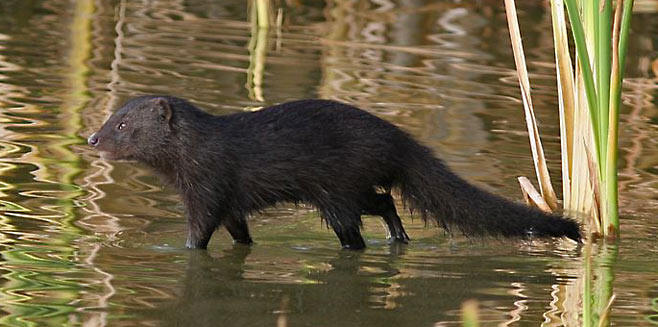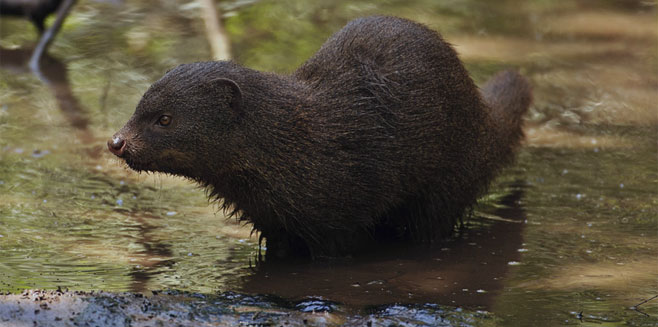|
Atilax paludinosus
(Marsh mongoose, Water mongoose)
kommetjiegatmuishond [Afrikaans];
Sumpfichneumon, Sumpfmanguste [German];
mangouste des marais [French];
nguchiro wa maji [Swahili];
imvuzi [isiNdebele];
umhlangala
[isiXhosa];
umvuzi [isiZulu];
motswitswi
[Sesotho];
tshaagane [Setswana];
chidzvororo [Shona];
liduha [siSwati];
mukala [Lozi];
ugwagara [Yei]
Life
>
Eukaryotes >
Opisthokonta >
Metazoa (animals) > Bilateria > Deuterostomia >
Chordata > Craniata > Vertebrata (vertebrates) >
Gnathostomata (jawed vertebrates) > Teleostomi (teleost
fish) > Osteichthyes (bony fish) > Class:
Sarcopterygii (lobe-finned fish) > Stegocephalia
(terrestrial vertebrates) > Reptiliomorpha > Amniota >
Synapsida (mammal-like reptiles) > Therapsida > Theriodontia
> Cynodontia > Mammalia (mammals)
> Placentalia (placental mammals) > Laurasiatheria
> Ferungulata > Ferae > Carnivora > Family:
Herpistidae (suricates and mongooses)
 |
|
Atilax paludinosus
(Marsh mongoose), Rondevlei Nature Reserve. [photo Trevor
Hardaker ©] |
 |
|
Atilax paludinosus
(Marsh mongoose), Walter Sisulu Botanical gardens, Gauteng, South
Africa. [photo
Callie de Wet ©] |
Identification
The marsh (or water) mongoose is the most
aquatic of all the mongoose species. Its coarse coat is shaggy and
uniformly dark –brown. The animals do vary from reddish brown to
almost black in colour. While it has a typical elongated mongoose
body shape, its shaggy coat makes it look less slender. The head is
long and pointed with short hair, the ears are small and rounded and
situated on the sides of the head. The feet are also covered in
short hair and there is no webbing present between the toes. The
toes have long non-retractile claws that are adapted for digging. An
unfamiliar animal to many people it is often confused with an
otter although it is much smaller and
darker in colour. The canines are heavily built with narrow blade
like process on the front and back edges, but these teeth do tend to
wear to blunted points. The carnassial teeth show a clear adaptation
to crushing rather than slicing.
Size
Body length 80-100 cm; shoulder height 22
cm; weight range 2.5 –5.5 kg.
Dental Formula
I C C P P M M =
36-40 =
36-40
Distribution and habitat
Widespread throughout southern Africa, but does
not occur in the arid interior. Associated with well-watered areas,
dams, estuaries, lakes, vleis, swamps and along rivers and streams.
General behaviour
As its name suggests the marsh mongoose is
closely associated with water and although it may range some
distance from water at times. They also utilize temporary stream
beds where there are pools, and will forage along beaches and in
tidal rock pools in coastal areas. Aquatic food is hunted in the
shallows and it uses its feet to dig in the mud and to feel under
rocks and in crevices. It opens fresh water mussels by using its
front feet to throw them backwards through its back legs against
rocks. Prey items collected in the water are taken to the drier
water edge to be eaten.
Mainly nocturnal, they may also be active in
the late afternoon and early morning. Marsh mongooses are usually
solitary although they may be seen in pairs and females accompanied
by young. Their home ranges tend to follow the line of the river bed
or the banks of the water body. As would be expected this mongoose
swims very well but apparently not readily, and they spend most of
their time wading in the shallows. They will fully submerge with
their eyes open in search for prey. They use latrine sites at the
water’s edge where they accumulate their droppings. During the day
they lie up in “forms” (shallow depressions in the ground or grass),
usually concealed under bushes amongst some grass.
Food
Predominantly crabs (particularly
Potamonautes) and
amphibians (frogs and toads) but diet also includes small
rodents,
birds,
fish,
insects,
reptiles and some wild fruits.
Reproduction
Each female holds a territory. After a
gestation period of about 60 days, litters of 1 – 3 young are born
and hidden in burrows, rock crevices or in dense undergrowth. At
birth the pups are fully furred, but their eyes and ears are closed
opening after about a fortnight. Weaning starts at about a month and
at 3 months the young will start killing their own rodent prey. Life
span: 16 years (in captivity).
Conservation
Mongooses are widespread and a successful group
and no species is known to be in danger of extinction.
Text by Denise Hamerton |
